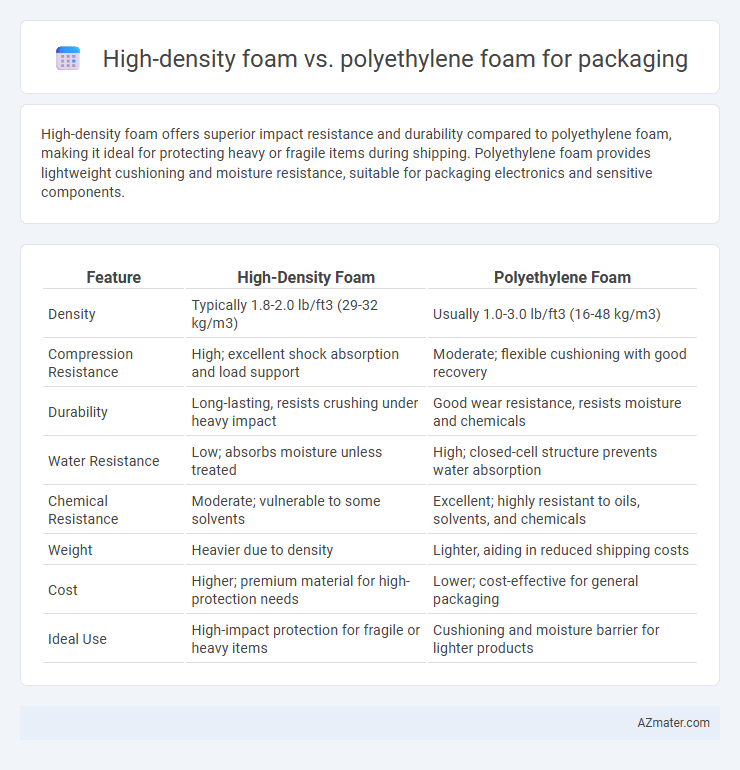High-density foam offers superior impact resistance and durability compared to polyethylene foam, making it ideal for protecting heavy or fragile items during shipping. Polyethylene foam provides lightweight cushioning and moisture resistance, suitable for packaging electronics and sensitive components.
Table of Comparison
| Feature | High-Density Foam | Polyethylene Foam |
|---|---|---|
| Density | Typically 1.8-2.0 lb/ft3 (29-32 kg/m3) | Usually 1.0-3.0 lb/ft3 (16-48 kg/m3) |
| Compression Resistance | High; excellent shock absorption and load support | Moderate; flexible cushioning with good recovery |
| Durability | Long-lasting, resists crushing under heavy impact | Good wear resistance, resists moisture and chemicals |
| Water Resistance | Low; absorbs moisture unless treated | High; closed-cell structure prevents water absorption |
| Chemical Resistance | Moderate; vulnerable to some solvents | Excellent; highly resistant to oils, solvents, and chemicals |
| Weight | Heavier due to density | Lighter, aiding in reduced shipping costs |
| Cost | Higher; premium material for high-protection needs | Lower; cost-effective for general packaging |
| Ideal Use | High-impact protection for fragile or heavy items | Cushioning and moisture barrier for lighter products |
Introduction to Packaging Foams
High-density foam offers superior cushioning and impact resistance, making it ideal for protecting delicate and heavy items during shipping. Polyethylene foam provides excellent moisture resistance and lightweight, versatile padding suitable for a wide range of packaging applications. Both foams are essential in packaging solutions, balancing protection, durability, and cost-effectiveness according to specific product needs.
What is High-Density Foam?
High-density foam is a resilient, rigid material composed of tightly packed polyurethane or polyethylene cells, offering superior cushioning and impact resistance in packaging applications. Its higher density ranges typically from 2 to 4 pounds per cubic foot, providing enhanced protection for fragile or heavy items during shipping. Compared to lower-density foams, high-density foam delivers greater durability, compression resistance, and dimensional stability, making it ideal for secure packaging solutions.
What is Polyethylene Foam?
Polyethylene foam is a versatile, closed-cell foam known for its excellent cushioning, impact absorption, and water resistance, making it ideal for protective packaging applications. It offers superior durability and flexibility compared to high-density foam, providing enhanced shock absorption for sensitive items during shipping. Polyethylene foam is lightweight and resistant to chemicals, ensuring long-lasting protection in various environmental conditions.
Key Differences Between High-Density Foam and Polyethylene Foam
High-density foam offers superior rigidity and impact resistance compared to polyethylene foam, which is softer and more flexible, making it ideal for delicate item protection. Polyethylene foam is more lightweight and moisture-resistant, providing excellent cushioning and insulation properties for packaging sensitive electronic components. The key differences lie in their density, durability, and moisture resistance, influencing the choice based on specific packaging requirements and environmental conditions.
Durability and Strength Comparison
High-density foam offers superior durability and strength compared to polyethylene foam, making it ideal for packaging heavy or fragile items. Its dense cellular structure provides enhanced impact resistance and better cushioning against shocks and vibrations. Polyethylene foam, while lighter and more flexible, generally exhibits lower compressive strength, making it less effective for protecting delicate or weighty products during transit.
Shock Absorption and Cushioning Performance
High-density foam offers superior shock absorption due to its ability to compress under impact while quickly regaining shape, making it ideal for protecting fragile items during transit. Polyethylene foam provides excellent cushioning performance with its closed-cell structure that resists moisture and prevents vibration damage. Choosing between the two depends on the specific packaging needs, with high-density foam favored for heavy-duty impacts and polyethylene foam preferred for lightweight, moisture-sensitive products.
Cost-Effectiveness for Packaging Solutions
High-density foam offers superior cushioning and durability for packaging, making it ideal for protecting fragile items during transit, but it generally comes at a higher cost compared to polyethylene foam. Polyethylene foam provides excellent impact resistance and moisture resistance at a lower price point, making it a more cost-effective choice for bulk or less delicate packaging needs. Evaluating the balance between protection level and budget constraints is essential for optimizing packaging solutions with the appropriate foam material.
Environmental Impact and Sustainability
High-density foam offers superior cushioning for packaging but typically involves petrochemical-based production processes with limited biodegradability, impacting environmental sustainability negatively. Polyethylene foam, although also derived from non-renewable resources, is often recyclable and lower in weight, which reduces transportation emissions and contributes to a lower overall carbon footprint. Choosing between these foams requires balancing durability needs with end-of-life recyclability and the potential for environmental degradation.
Ideal Packaging Applications for Each Foam Type
High-density foam is ideal for packaging heavy, fragile items such as electronics, machinery parts, and medical equipment due to its superior compressive strength and impact resistance. Polyethylene foam is better suited for lightweight, irregularly shaped products like glassware, ceramics, and food containers because of its flexibility, cushioning properties, and moisture resistance. Choosing the appropriate foam depends on the product's weight, fragility, and environmental exposure during transit and storage.
Choosing the Right Foam for Your Packaging Needs
High-density foam offers superior cushioning and durability, making it ideal for protecting heavy or fragile items during shipping, while polyethylene foam provides excellent impact absorption and moisture resistance at a more cost-effective price, suitable for general packaging requirements. Consider the product's weight, fragility, and shipping conditions to determine the appropriate foam type that balances protection and budget. Selecting the right foam enhances product security, reduces damage rates, and ensures customer satisfaction in packaging solutions.

Infographic: High-density foam vs Polyethylene foam for Packaging
 azmater.com
azmater.com